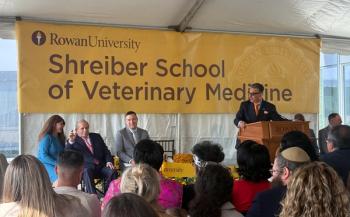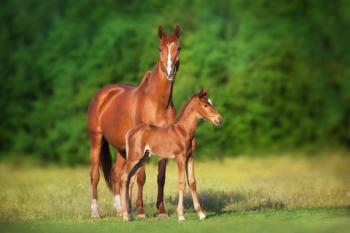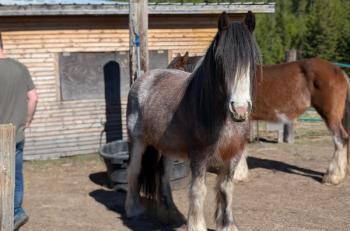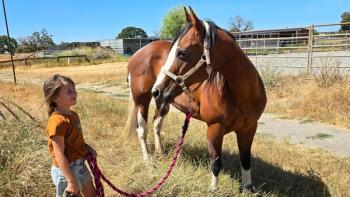
Why is this mare not exhibiting normal estrous cycles and what can I do? (Proceedings)
By definition, the complete reproductive cycle includes a period of estrus, concluding with ovulation and a period of diestrus when progesterone levels are elevated. Observing periodic estrous behavior does not prove cyclicity. Evidence that ovulation is occurring can be from sequential data from ovarian palpation, presence of a corpus luteum as shown by ultrasonography or elevation of serum progesterone levels.
A. Mares that fail to cycle
• Causes
• Seasonality
• Spontaneous prolongation of the corpus luteum
• Behavioral anestrus
• Lactational anestrus
• Tumors
• Anovulatory follicles
• Endometritis
• Developmental abnormalities
• Increased age
• Poor body condition score (< 4 out of 9)
• Systemic problems such as chronic pain
By definition, the complete reproductive cycle includes a period of estrus, concluding with ovulation and a period of diestrus when progesterone levels are elevated. Observing periodic estrous behavior does not prove cyclicity. Evidence that ovulation is occurring can be from sequential data from ovarian palpation, presence of a corpus luteum as shown by ultrasonography or elevation of serum progesterone levels. Presumptive evidence of ovulation includes firm uterine and cervical tone and presence of follicular activity on the ovaries.
Seasonal effects on the reproductive cycle are a common cause for failure to cycle or abnormal cycles in the winter and spring. In the winter the content and secretion of the GnRH from the hypothalamus is drastically reduced. Shortly after the winter solstice GnRH secretion begins to increase through mechanisms not completely understood. Follicular Stimulating Hormone increases presumably in response to the increase in GnRH and follicles begin to develop on the ovaries. During this time little if any LH is secreted as the gene for LH synthesis is essentially turned off. The pattern of follicular growth during vernal transition is relatively predictable, with increased size and numbers of follicles. Of major importance, the first several follicles that form in vernal transition do not ovulate, although they may reach normal preovulatory size (>30 mm). Mares make on average 3.7 ±.9 follicles that reach a size of 30 mm or greater that do not ovulate during the transitional phase. These follicles are not steroidogenically competent and do not produce estrogen. This leads to reproductive inefficiency as it is difficult to know whether a given follicle is competent and whether it will ovulate. Monitoring development of a follicle over time may be useful in determining the eventual status and outcome of a transitional follicle because the growth rate of follicles destined to regress is considerably slower than that of the follicle which eventually ovulates. Shedding of the long winter hair coat in spring is a rough indicator of impending ovulation as shedding is closely associated with reproductive renewal. While it is not known what factors contribute to the development of the first competent follicle, it is clear that this follicle, destined to be the first to ovulate in the year, is steroidogenically competent. The first ovulatory follicle of the year is accompanied by a surge of plasma estradiol that is followed by a surge in LH.
Clinical signs
The transitional period can be accompanied by long periods of erratic ovarian and estrous behavior. Ovaries of mares in late transition usually have several follicles of varying sizes and maturity. The associated prolonged estrous behavior can last from 1 week to 4 months or more. Clients unfamiliar with the seasonality of the reproductive cycle of the mare will typically assume that the mares have ovulated and may breed the mare during this time.
Management
Artificial lighting schemes
Artificial light, applied 60 days before intended breeding season is the best method of managing mares if one wishes to move the vernal transition forward from April to February in the Northern hemisphere or from October to August in the southern hemisphere. Light added at the end of the day, to yield a total of 14 to 16 hrs of light daily results in mares resuming cyclicity in 60 to 75 days. Mares exposed to lights on December 1 (June 1-southern hemisphere) usually cycle by February 15th (August 15-southern hemisphere). Older mares (> 18 yrs of age) will take longer before they ovulate in the spring. Too much light (> 16 hr per day) or prolonged periods of light may actually delay the onset of cyclic activity.
The intensity of light required to induce an early first ovulation of the season has been shown to be as low as 10 lux, the light produced with a 20 W white incandescence bulb in a 12 x 12 foot box stall (4 x 4 meters). Mares subjected to 14.5 h of light using a 10 lux lamp each evening beginning at the winter solstice had plasma progesterone concentrations greater than 1 ng/ml by 62 ± 6 days (Means ± SEM), similar to that of mares subjected to high intensity light (100 lux; 64 ± 15 days). Work from France indicates that mares ovulated a mean of 76 ± 4 days when subjected to 14.5 hours of light daily for 35 days starting at the winter solstice (Dec 21). Mares subjected to this protocol resumed cyclicity at the same time as those mares subjected to artificial light for 60 days (76 ± 4 days).
Hormonal Methods to Hasten 1st Ovulation of the Year
Behavioral anestrus
Mares that will not exhibit estrus to the stallion include dams that are protective of their foal, young race mares off the track and nervous timid mares. The condition can be identified by ultrasonography. Treatment is prostaglandin
Lactational anestrus
Mares that experience lactational anestrus usually will exhibit a "foal heat" only to develop small ovaries with minimal follicular activity at the 30 day estrus. Causes include: foaling during short days, endometritis, pain, stress and unidentified endocrine abnormality. When presented such a mare, one should first determine if there is endometritis and perform a physical examination including evaluation of the musculo-skeletal system to identify if pain may be contributing to the problem. If either of these conditions exist, the mare should be treated appropriately. If the condition appears to be inappropriate light exposure, mares should be placed under lights for a total of 14.5 h daily. After 10 to 14 days of light exposure, one can administer a dopamine antagonist or GnRH for 10 to 15 days (see chart above). If the mare does not respond within that time, it is likely that she will not do so with a more protracted treatment schedule. Other treatments that have had some success include twice daily administration of eFSH (6.25 mg) once a follicle of 18 mm or greater has developed or 65 micrograms of Deslorelin every 12 h for up to 5 days.
Spontaneous prolongation of the corpus luteum
Estrous cycle length can be prolonged during the cyclic season due to prolongation of the CL. This is most commonly due to a mid-cycle ovulation that results in the formation of a second CL during the diestrus phase. There is also anecdotal evidence that a CL may not fully regress at the end of the diestrus phase. Mares will have a bright, white CL visualized on ultrasonography. Plasma progesterone level will be greater than 1ng/ml. Treatment is administration of prostin or a prostaglandin analog such as cloprostenol.
Ovarian Tumors
Granulosa-theca cell tumors are the most commonly reported neoplasm of the equine ovary. They are generally benign, steroid-producing neoplasms with variable effects on mare behavior, depending upon the hormone levels attained. Mares may exhibit anestrus, continuous or intermittent estrus, or stallion-like behavior, Granulosa cell tumors are almost always unilateral, slow growing and benign.
Clinical findings and diagnosis
Granulosa-theca cell tumors are diagnosed by history, behavior, rectal palpation and ultrasonography. Mares may exhibit anestrus behavior, constant or irregular estrus, or stallion like behavior. A mare may have a granulosa cell tumor and continue to exhibit normal estrus cycles and ovulate off the other ovary. On rectal palpation, one ovary will be abnormally large with no palpable ovulation fossa. The contralateral ovary is usually small, firm and inactive. Ultrasonography often reveals a multicystic or honeycombed structure. The tumor may also be dense, knobby, smooth or appear as a solid ovarian mass with a single, large, fluid-filled cyst. Some tumors may contain one or more hematomas within the stroma. Mares with granulosa cell tumors must be differentiated from mares with a hematoma. Mares with hematomas continue to cycle every 18 days, the contralateral ovary is active, the uterus will have tone during diestrus and the ovulation fossa can be palpated.
Clinical diagnostic assays for the detection of a granulosa cell tumor include the measurement of inhibin, testosterone and progesterone. Inhibin is elevated in approximately 90% of the mares with a granulosa cell tumor. Serum testosterone levels may be elevated if a significant theca cell component is present in the tumor. Testosterone is elevated in approximately 50-60% of affected mares and is usually associated with stallion like behavior. Progesterone concentrations in mares with a granulosa cell tumor are almost always below 1 ng/ml, since normal follicular development, ovulation and corpus luteum formation do not occur. Inhibin concentrations > 0.7ng/ml, testosterone concentrations > 50-100pg/ml, and progesterone concentrations of < 1 ng/ml are suggestive of a granulosa cell tumor.
Treatment
Treatment for secreting ovarian tumors is ovariectomy of the affected ovary, if future fertility is desired. When surgery is not elected, the owner should be informed of the mare's possible future discomfort and even hemorrhage from ruptured ovarian ligaments caused by the enlarge ovary. Metastasis is extremely rare. The prognosis for fertility after successful removal of a granulosa cell tumor is favorable. Most mares will cycle within the next 9 months. If ovariectomy is performed during the winter, resumption of cyclic activity usually is delayed by the natural seasonality of the mare.
Anovulatory follicles
Anovulatory follicles are more common in aged mares. The cause is not know but two theories put forward include an inability of the follicle to respond to LH and prostaglandin release from chronic endometritis. Mares with the condition will exhibit normal estrous behavior but estrus will be prolonged and the follicle will continue to grow. On ultrasonographic evaluation, anovulatory follicles develop either hyperechoic particles within the fluid filled lumen as they increase in size, fibrous strains within the lumen or a thick white rim along the perimeter of the follicle. Mean size of anovulatory follicles is approximately 50 mm in diameter. Treatment with either human chorionic gonadotrophin (hCG) or deslorelin (GnRH agonist) is futile as the follicles will not ovulate. About 65% of anovulatory follicles will eventually produce progesterone while the remaining 35% do not. Those follicles that do produce progesterone will respond to prostaglandin. As anovulatory follicles have been associated with chronic endometritis, a small volume flush of the uterus should be obtained from mares that repeatedly form anovulatory follicles to ensure that there is no endometrial inflammation or infection.
Developmental abnormalities
The karyotype of the normal mare and stallion are 64, XX and 64 XY, respectively. Chromosomal abnormalities, especially of the sex chromosomes, have been associated with infertility in the horse. A chromosomal abnormality may be suspected in a mare of breeding age with primary infertility and gonadal hypoplasia. The most commonly reported chromosomal abnormality of the horse is 63, X0 gonadal dysgenesis, in which only a single sex chromosome is present. The equine condition is analogous to Turner's syndrome in humans. Horses with gonadal dysgenesis develop as phenotypic females because of the absence of a Y sex chromosome. Characteristic clinical findings include extremely small ovaries (usually less than 1 cm), with no germinal tissue, infantile uterus often no more than a thin band of tissue, a flaccid, pale, dilated cervix and normal external genitalia. The external genitalia is female, but the vulva may be smaller than normal and ther is no clitoral hypertropy. These mares show persistent anestrus or irregular periods of behavioral estrus. They may stand to be mated. Some affected mares may appear small in stature. No breed predilection has been observed.
Diagnosis
Diagnosis is made by karyotyping. Chromosome analysis can be performed on any tissue with actively dividing cells. A fresh blood sample collected into acid citrate dextrose or heparin may be sent by overnight courier to a laboratory specializing in animal karyotyping.
Newsletter
From exam room tips to practice management insights, get trusted veterinary news delivered straight to your inbox—subscribe to dvm360.






